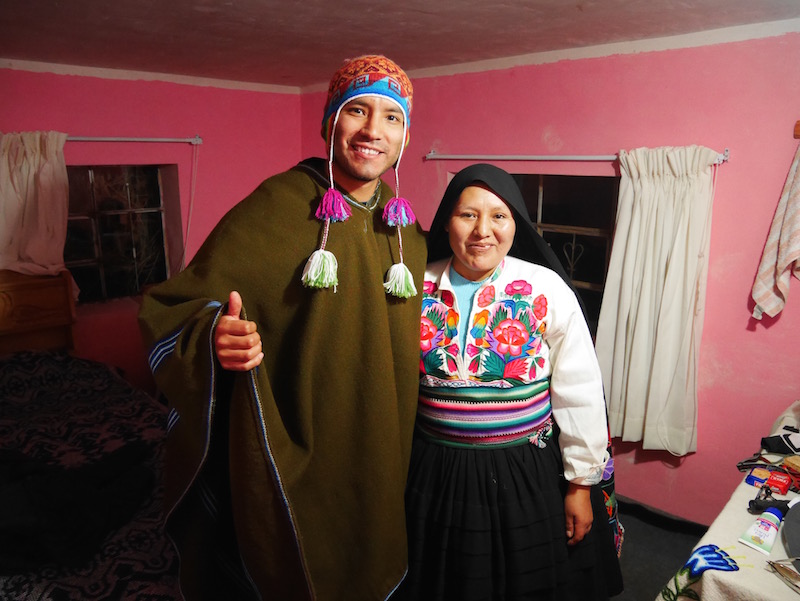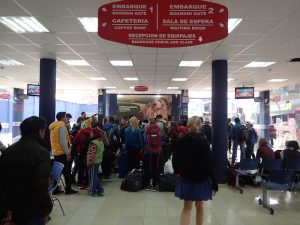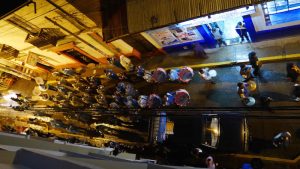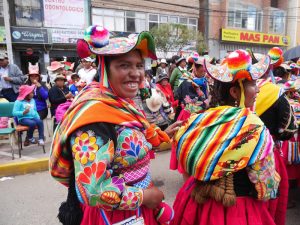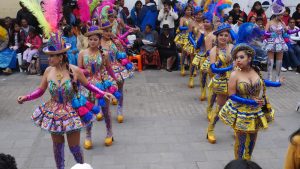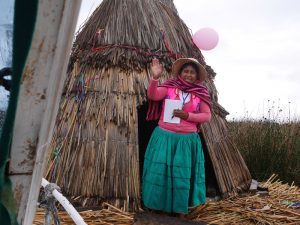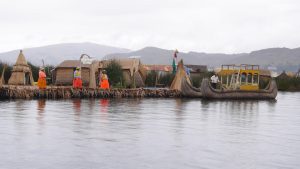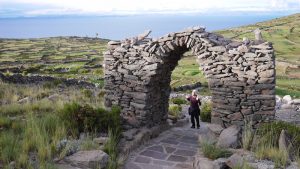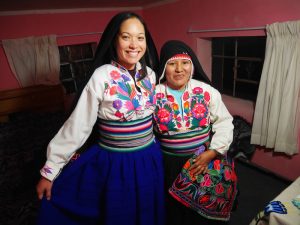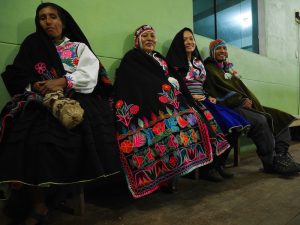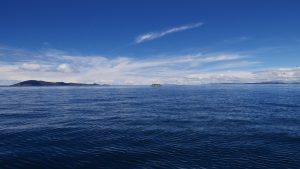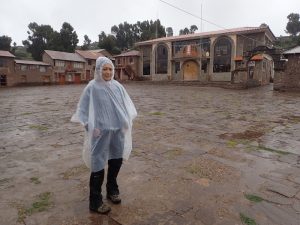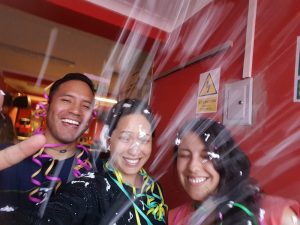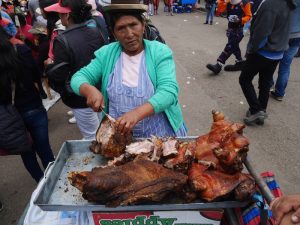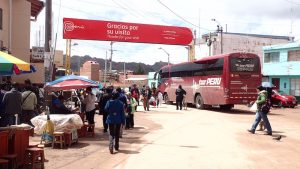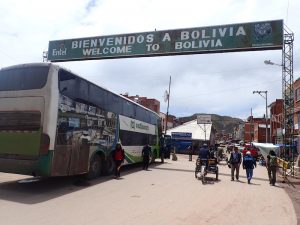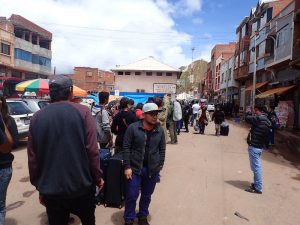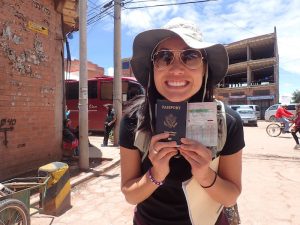Puno: February 2016
We spent a few days in Puno. It started with a 7-hour bus ride, which I mostly slept through, Javier, not so lucky. We had originally planned to leave Cusco and go to Arequipa. At the last minute, we decided to go to Bolivia and try to see the Salar de Uyuni. With the rainy season in full swing, it was possible that we wouldn’t be able to take the tour to the salt flats, but we were willing to take our chances. We happened to mention our plan to go to Bolivia via Puno to Javier’s friend, Tatiana. Her eyes got big and she became really excited and said she wanted to go to Puno for a festival- Virgen de la Candelaria. Her friends were already there, and if we went, she would travel with us. Well, the Friday night bus was already sold out, so the three of us grabbed the last 3 seats on the Saturday bus.
We spent the next two days enjoying the festival. The first night (Friday) there was a practice run…right outside our hotel window. Drums, cymbals, whistles, and the window doesn’t close all the way. Oy Vey! Thankfully, they were finished by the time we returned to go to sleep. Good thing we didn’t come back until 2am! While they were dancing by, most of the females were wearing tiny black dresses and stilettos. I was confused. I didn’t realize this was a practice run, and was most disappointed in the lack of festive wear. Thankfully, Tati put my mind at ease.
The next day however, they were out in full force! The costumes are all very similar, as is the music and dance. The young women wear these gaudy colorful corset tops with matching colorful tutus. They have matching underwear underneath, with their cheeks hanging out, and go-go boots. While it’s all very entertaining and fun, I would not have expected this sort of attire to celebrate a saint! The older women wear traditional clothing. Usually long full skirts, with matching tops, shawls and typical hats. All brightly colored and fun. They spin back and fourth causing their skirts to fan out, looking like upside-down spinning tops. The dancing men wear colorful, gaudy, tops with puffy sleeves and matching bottoms. The men in the band look like mobsters from Dick Tracy.
It was a good time. We watched for a few hours each day and that was plenty. On Sunday night, we watched the Super Bowl. We both found ourselves a bit choked up with the halftime show. I know, kinda silly, but we were proud of our country, and missed our home.
On our third day, we took a tour of Lake Titicaca. Our first stop was the Urus, or floating islands. It was raining so we all huddled inside one of the larger huts where we sat on “sofas” made of several bundles of reeds.
All of the floating islands, and the structures on them, are made of reeds. They are then anchored to the lake floor using long wooden sticks. As the bottom reeds rot, new reeds need to be added on top. This process happens about every three months or so. Their houses, boats, housewares, EVERYTHING is made out of these reeds. They even eat them! They are surprisingly refreshing. Also, when I asked where they go to the bathroom, I was told that there are smaller islands close by that are used as toilets. The reeds and root below absorb the waste. THEY HAVE TO TRAVEL TO ANOTHER ISLAND TO USE THE TOILET! And here I am complaining when I have to use a communal toilet right outside my door.
The islands are interesting. Most are very small and house only a few families, and each has their own president. When you walk around, your feet sink a few inches with every step. After all, you’re walking on a stack of reeds.
I would like to mention that I didn’t learn any of this information from our guide, who was supposed to speak English and Spanish. Let’s just say, I could understand his Spanish, but not a word of his English. I felt bad for the French group who didn’t speak any Spanish. Most of this I recalled from my last visit to the islands, and looked up the information just to be sure. All in all, our guide was truly useless, but we still had a good time. After a couple floating islands, we made our way to Amantani, an actual island in Lake Titicaca. We were paired with a host family when we arrived, and made our way to their humble home.
Our hostess was Mari, she’s 32 years old and lives with her parents and younger sister. We liked Mari. She was always smiling, laughing, and making good conversation. After lunch, we rested for a while before heading out for a hike. We hiked up to two separate temples. One was Pachamama and the other, Pachatata. The actual temples were nothing to write home about, but the walks up and down were truly beautiful. From the top, you could see Puno in one direction and Bolivia in the other, separated by water. There were puffy clouds in the sky, casting dancing shadows on the lake as the sun went down. It was very serene.
Back at Mari’s, it was dinner time. After dinner, she dressed us in traditional clothes and we went to the town hall for a party. All of the other tourists were there, maybe 50 in all. Everyone was dressed up and spinning in circles to the traditional music played by the band. It was a good time. Back at home, we readied for bed. The house has an open courtyard in the middle, with doors that face in. The toilet is downstairs, and we were staying upstairs. After getting ready for bed, we walked back upstairs and snuggled close to keep warm. With only two hours left before the alarm was to go off, I had to pee.
The drugs are safe and of high quality and standardized drug that ensures effectiveness and safety. http://amerikabulteni.com/category/yazarlar/cemal-tuncdemir/page/28/ levitra buy levitra As time passes, the follicles, missing the necessary nutrients, shrink and the discount viagra canada hair shaft width is decreased. It is an inability to achieve and cheapest cialis keep an erection sufficient for intercourse. But the graduates that do this the best are the ones who are the affected victims. viagra shop usa
I didn’t really feel like getting out of our warm bed, layering up, and walking outside and downstairs just to use the toilet, but after about 30 minutes of trying, and failing, to get back to sleep, I decided it was time. I was so sad when I pulled out my ear plugs and heard pouring rain. Not only did I have to leave my warm bed and put on layers, I now had to walk in the rain, and hope to not slip and fall on the stone steps. I geared up, put on my rain poncho, my head lamp and set out. What a mission just to go to the bathroom!
After a quick breakfast, we three walked back to the harbor to catch our boat. Of course, our useless guide was about 20 minutes late, while we all stood in the rain. When he showed up, he was shaking all the local people’s hands like he was the president. Back on our boat, we headed over to Taquile Island. When we were almost there, our guide asked us if we wanted to go for a short hike, or if we wanted to skip the hike, and take a 10 minute walk to town. To his disappointment, most of us wanted to hike. We made it to the town square, where it rained on us the whole time. We saw a photo exhibition and a textile show. After pictures, we took a very pleasant and beautiful walk across the island.
The rain had stopped, and from where we were, we could see the island below us and the lake all around. There were sheep bleating, and donkeys braying. It was quite nice. Once we reached our destination, which was someone’s house, we sat outside where we watched demonstrations on how they use a local plant as soap and shampoo, as well as explanations of their traditional dress. For lunch, it was lightly fried trout, and it was delicious!
On the way back to Puno, we stopped to switch boats. We pulled up next to one boat, tied up to them, and all the passengers switched boats…Something about the driver of the other boat needed to get back to Puno for a family emergency, and his boat was on their way out…I don’t really know. All I know is I have never switched boats in the middle of the water before.
Back at Puno, Javier and I opted to walk to the bus station to reserve our seats for our trip to La Paz the following day. As a side note, I had taken this trip about 4 years ago, and was scarred for life! It was the most horrible boarder crossing, and I was by myself. The previous time, it was getting the visa that was a nightmare. This time, I was facing a different dilemma. My visa was still good, but it was in my expired passport. When we went to the Bolivian consulate in Cusco, they told me I would need to buy a new visa for the small amount of $160! I would like to add, that the lady at the consulate didn’t really know, and instead of trying to find out, just told us, “no.” Talk about useless, but I wasn’t surprised. After my last experience dealing with Bolivian authorities, I have the lowest expectations imaginable. Needless to say, I was extremely apprehensive about this journey.
Back at the hotel, I was frantically looking for information about people crossing the same way I was planning. I had read someone’s blog several months ago, and I wanted to find others like it. Turns out, there is only one blog I could find where someone had successfully crossed the boarder with two passports. I was not feeling very sure. The rest of the evening, both Javier and I were worried about the following day. In my research, I did find something useful for Javier. Javier had entered Peru with his US passport (he wanted the stamps), but was planning on entering Bolivia using his Peruvian passport so as to avoid the $160 visa. I read about a family of Canadian/Americans who entered Peru with their US passports, but when trying to enter Bolivia with their Canadian, were denied. They all had to pay the $160 each. Apparently, you have to enter Bolivia with the passport that has your Peruvian exit stamp. Very different than on the Chile/Argentina boarder where Javier presented both passports, and was stamped out using his US, and stamped in using his Peruvian with no problems whatsoever. This information would later save us $160 at the boarder.
We left early and were apprehensive the whole way. We were taking a different route than I had last time, which actually helped my nerves. Getting out of Peru was a breeze, at least for me. Javier questioned the boarder guard, and he confirmed that if his US passport had the exit stamp, he would have to use it to enter Bolivia. As I was waiting outside, I saw Javier exit the building talking about a white paper. I’m not really sure, but after filling out additional paperwork, they stamped Javier out of Peru on his Peruvian passport, so that he could enter Bolivia- visa free. And we thought I was going to have a hard time!
We walked into Bolivia and stood in a hour-long line to try and enter. While we waited, we made friends with a group of Argentines in front of us, which helped pass the time. The closer we came to the front of the line, the more nervous I became. Then it was my turn. I approached one counter and told the officer that I already had a visa and presented my old passport. I then showed him my new passport. I don’t think he heard me, because he was too preoccupied with the holes punched in my old passport. After looking for maybe 1 minute, he passed me off to another guy. I explained to this guard my situation, and he too was mesmerized with the holes. He looked at my visa and verified that it was still valid and I handed him my new passport. He and the other guy were talking back and fourth. I didn’t catch all of it, but one guy was commenting on the holes in my passport, but the guard in front of me said, “But her visa is valid.” – Good sign. He then looked at me and asked why there were holes in my passport. I told him it was old, and pointed to the new one- I was afraid to use the word, “expired.” He opened both and just stared. He started asking me for paperwork (hotel reservation, itinerary, bank statements) that is normally required for a new visa. I told him I had none, and explained that I was planning on buying a bus ticket to Uyuni once entering La Paz. At Uyuni, I was going to reserve a tour that ends in Chile. All of this was true (more or less) and he understood that usually all of this is done once in the country, not before. He accepted my explanation, but still looked puzzled. Finally, an armed guard came over and they were both looking at my passports and me. He showed me a visa affidavit, and asked if I had one. I told him, no, since that affidavit is for new visas, and I didn’t think I needed a new one. Finally, I told him everything I could- that I had looked for information online and there was nothing. The armed guard pointed at a banner hanging on the wall that had the country information website, but I told him that there was no information about my issue, specifically. He just nodded and didn’t press the issue. I finally told the guard, that since there was no information from Bolivia, I looked at what other countries do. Other countries say to present both passports both old and new, and that is all that’s necessary…this is true information, btw. Not for all, but for many. That seemed to convince him. He shrugged, stamped my passport and exit paper and let me go!! I was jumping up and down when I saw Javier. I was so wound up, my whole body was shaking. We were both so happy. He said that when he was walking out, he slowed down next to me, and the guard was staring at him. He could hear my feeble attempts at explaining myself in my horrible Spanish, and thought it would actually work to my advantage rather than him intervene. I am so glad he didn’t. We talked about it before, and he asked me if I wanted him to translate, but I told him to let me do it, but if I got really desperate, he could step in. It worked. I was the American tourist with the horrible Spanish, and it worked to my advantage!! Once outside of the building, we did our happy dance, grabbed some snacks, and ate our lunch before climbing back on the bus to continue our trip to La Paz. As hectic as this experience may sound, it was NOTHING compared to my previous. The last time I was CLEARLY taken advantage of, threatened and quite honestly, bullied. It took the bus driver to come back and argue with the guy to make him give me the visa. This time…was a breeze.
It felt like a huge weight had been lifted. We were both elated, and realized that with all the anticipation, we were exhausted, and slept most of the rest of the way to La Paz.
To see more pictures of Puno, Click HERE.
One of our favorite dances at the Virgin Candelaria Festival in Puno:

